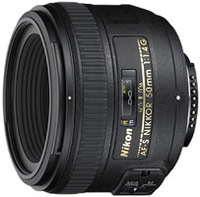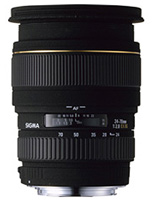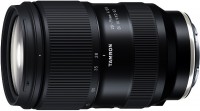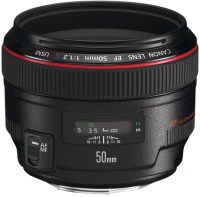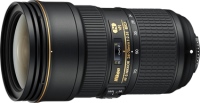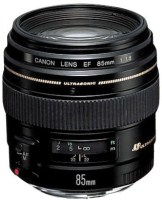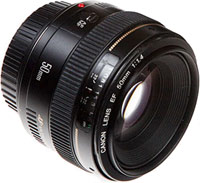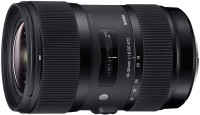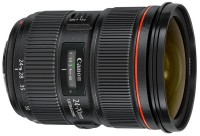Camera Lenses Canon f/1.4
Choose Model camera and choose camera lens ↓ Apply | All Camera Lenses Advanced filters → |
You might be interested in
Articles, reviews, useful tips
All materials
Deciphering the designations of Sony lenses
Learning to read information about an object by abbreviations in its name

TOP 5 popular lenses for Micro 4/3 mirrorless cameras
A set of optics for Olympus and Panasonic mirrorless cameras with a Micro 4/3 image sensor

Panasonic and Olympus lens markings
We understand the designations on board optics compatible with Micro 4/3 format cameras

Five of the best portrait lenses for Sony full-frame mirrorless cameras
High-quality optics for shooting portraits on full-frame mirrorless cameras from Sony

Fuji Lens Marking Secrets
The combination of symbols in the name of the object reveals its entire background

How does autofocus work?
When it comes to focusing on sharpness when taking photos and videos, automation can be fully relied on
Camera Lenses: specifications, types
Lens type
General lens type. Note that this parameter is largely determined by the equivalent (not actual) focal length, but in the characteristics of optics, the actual value is most often indicated; see "Focal length" for more on this.
The type is not indicated for any optics, but only for models that have a pronounced specialization and clearly fit into a certain category. In addition to them, there are so-called universal lenses — see below about them. And s...pecialized models can be of the following types:
— Fix. This category on our website includes almost all lenses that do not provide the ability to change the focal length. These can be wide-angle models, and optics with a long focal length, providing a high degree of magnification, and models with average values; the only exception is the ultra-wide-angle fisheye, which is a separate type (see below). Due to the simpler design, fixes are usually cheaper and more reliable than similar zoom models. Their main disadvantage is the actual constant focal length. Because of this, when working with fixes, you have to have your own lens for each type of shooting, and zooming in / out of the image is carried out solely by moving the camera closer / farther relative to the object being filmed (in professional jargon — “zoom with your feet”).
— Wide angle. Zoom lenses, the minimum value of which is up to 18 mm inclusive, the maximum is up to 40 mm inclusive (both are in 35 mm equivalent). This provides a wide viewing angle with virtually no visible distortion (unlike ultra-wide-angle models, see below). "Wide angles" are often used for shooting landscapes, large objects, etc.; also, such a lens can be useful in tight conditions, where you need to capture the widest possible scene (for example, a large group of people), and the situation does not allow you to move far away.
— Ultra wide angle. Also, this type of lens is called fisheye, or "fisheye". Their equivalent focal length is up to 17 mm inclusive, and viewing angles can reach 180° and even more, which allows capturing a very large area of the surrounding space in one picture (for example, the sky around the entire circumference of the horizon). Such lenses have noticeable distortion in the resulting image: the centre of the frame looks closer than the edges, and straight lines that do not pass through the centre of the frame become crooked. Because of this, fisheye optics got their name: the view through it is similar to how a fish sees the ground from under the water. Most often, fisheyes have a fixed focal length, but there are also zoom lenses. Such lenses are used, in particular, to create panoramas, shooting in confined spaces, as well as to provide artistic effects.
— Tele. Lenses with a long focal length and, accordingly, a high degree of magnification, designed primarily for shooting at long distances. If we talk about specific numbers, then in our catalog telephoto lenses include models with a variable focal length, in which the lower limit of the focal length is at least 50 mm, and the upper limit is at least 200 mm. Such optics can be convenient, in particular, when shooting nature, sports competitions and mass events.
In addition to those described above, many lenses are produced that meet the criteria for several types at once or do not fit into any of them. Examples include, in particular, an intermediate option between wide-angle and telephoto lenses with a focal length of 24 to 55 mm, or a model with an extensive adjustment range like 28 – 200 mm, covering both of these types. Such lenses without specialization are called universal. In general, their scope is quite wide, and most of the optics supplied in the kit (kit) with SLR cameras belong to the mentioned “intermediate option”. However in terms of image quality, universal models are often inferior to specialized optics with a similar price; on the other hand, a set of several specialized lenses often costs more than a high-end "station wagon" with the same capabilities.
The type is not indicated for any optics, but only for models that have a pronounced specialization and clearly fit into a certain category. In addition to them, there are so-called universal lenses — see below about them. And s...pecialized models can be of the following types:
— Fix. This category on our website includes almost all lenses that do not provide the ability to change the focal length. These can be wide-angle models, and optics with a long focal length, providing a high degree of magnification, and models with average values; the only exception is the ultra-wide-angle fisheye, which is a separate type (see below). Due to the simpler design, fixes are usually cheaper and more reliable than similar zoom models. Their main disadvantage is the actual constant focal length. Because of this, when working with fixes, you have to have your own lens for each type of shooting, and zooming in / out of the image is carried out solely by moving the camera closer / farther relative to the object being filmed (in professional jargon — “zoom with your feet”).
— Wide angle. Zoom lenses, the minimum value of which is up to 18 mm inclusive, the maximum is up to 40 mm inclusive (both are in 35 mm equivalent). This provides a wide viewing angle with virtually no visible distortion (unlike ultra-wide-angle models, see below). "Wide angles" are often used for shooting landscapes, large objects, etc.; also, such a lens can be useful in tight conditions, where you need to capture the widest possible scene (for example, a large group of people), and the situation does not allow you to move far away.
— Ultra wide angle. Also, this type of lens is called fisheye, or "fisheye". Their equivalent focal length is up to 17 mm inclusive, and viewing angles can reach 180° and even more, which allows capturing a very large area of the surrounding space in one picture (for example, the sky around the entire circumference of the horizon). Such lenses have noticeable distortion in the resulting image: the centre of the frame looks closer than the edges, and straight lines that do not pass through the centre of the frame become crooked. Because of this, fisheye optics got their name: the view through it is similar to how a fish sees the ground from under the water. Most often, fisheyes have a fixed focal length, but there are also zoom lenses. Such lenses are used, in particular, to create panoramas, shooting in confined spaces, as well as to provide artistic effects.
— Tele. Lenses with a long focal length and, accordingly, a high degree of magnification, designed primarily for shooting at long distances. If we talk about specific numbers, then in our catalog telephoto lenses include models with a variable focal length, in which the lower limit of the focal length is at least 50 mm, and the upper limit is at least 200 mm. Such optics can be convenient, in particular, when shooting nature, sports competitions and mass events.
In addition to those described above, many lenses are produced that meet the criteria for several types at once or do not fit into any of them. Examples include, in particular, an intermediate option between wide-angle and telephoto lenses with a focal length of 24 to 55 mm, or a model with an extensive adjustment range like 28 – 200 mm, covering both of these types. Such lenses without specialization are called universal. In general, their scope is quite wide, and most of the optics supplied in the kit (kit) with SLR cameras belong to the mentioned “intermediate option”. However in terms of image quality, universal models are often inferior to specialized optics with a similar price; on the other hand, a set of several specialized lenses often costs more than a high-end "station wagon" with the same capabilities.
Main function
The general purpose is rather conditional, and in fact the use of optics is not limited to the claimed direction — it all depends on the skills and imagination of the photographer. However, information about the specialization can greatly facilitate the choice. Considering such original options as a cinema lens and a multifunctional.
— Architectural. Lenses designed primarily for sho...oting buildings. Most of these models are equipped with the Tilt-Shift system (see below). In this case, this function is intended to correct the perspective when shooting tall buildings. In a photograph taken with a normal lens, straight lines can turn out to be curved, which is unacceptable in cases where an accurate representation of the building in the picture is required. Using the Tilt-Shift system allows you to avoid this phenomenon and get a reliable image that does not require additional correction in a photo editor.
— Landscape. In this case, landscape lenses include short-focus (wide-angle) lenses, which, according to test results, provide good image sharpness. In other words, not all “wide-angles” are classified as landscapes, but only those that are actually capable of providing a clear, sharp image.
— Portrait. The hallmarks of a classic portrait lens are: first, the fixed focal length, which is usually over 50mm (35mm equiv.); secondly, high aperture (most often not lower than f / 2.8, although occasionally there are exceptions). This combination of characteristics allows you to shoot portraits with beautiful background blur, placing the camera at a fairly significant distance; the latter can be useful in studios where additional lighting equipment is used — it is advisable to install the camera behind lighting fixtures so that it does not give a shadow. Speaking of a fixed focal length, it is worth recalling that "fixes" are simpler, lighter and cheaper than zoom lenses, and the ability to adjust the magnification when shooting portraits is rarely required — most often you can completely get by with "zoom with your feet".
— Multifunctional. This direction includes lenses of a universal type (see above), offering the buyer a good value for money; in other words — multi-purpose models with good performance and at the same time relatively inexpensive (namely, "comparatively", the actual price can be quite high). When choosing models in this category, the quality of filming was evaluated according to the results of real tests.
— Film lens. The main feature of cinema lenses is the ability to fine-tune the aperture. The aperture can be closed / opened by 0.1 or even 0.01 mm, while in photo lenses the aperture setting step cannot be less than 1 mm. Additionally, in cinema lenses, aperture is expressed by a T-number, and in photographic lenses, an F-number is used. The operator can shoot multiple cinema lenses with the same aperture, without the need to change the lighting. And when using photo lenses with the same aperture, you often have to adjust the lighting for each optic separately. Cinema lenses are meant to be shot from a tripod, which is reflected in their design features and design — such models are usually larger and heavier than their counterparts for photography.
— Architectural. Lenses designed primarily for sho...oting buildings. Most of these models are equipped with the Tilt-Shift system (see below). In this case, this function is intended to correct the perspective when shooting tall buildings. In a photograph taken with a normal lens, straight lines can turn out to be curved, which is unacceptable in cases where an accurate representation of the building in the picture is required. Using the Tilt-Shift system allows you to avoid this phenomenon and get a reliable image that does not require additional correction in a photo editor.
— Landscape. In this case, landscape lenses include short-focus (wide-angle) lenses, which, according to test results, provide good image sharpness. In other words, not all “wide-angles” are classified as landscapes, but only those that are actually capable of providing a clear, sharp image.
— Portrait. The hallmarks of a classic portrait lens are: first, the fixed focal length, which is usually over 50mm (35mm equiv.); secondly, high aperture (most often not lower than f / 2.8, although occasionally there are exceptions). This combination of characteristics allows you to shoot portraits with beautiful background blur, placing the camera at a fairly significant distance; the latter can be useful in studios where additional lighting equipment is used — it is advisable to install the camera behind lighting fixtures so that it does not give a shadow. Speaking of a fixed focal length, it is worth recalling that "fixes" are simpler, lighter and cheaper than zoom lenses, and the ability to adjust the magnification when shooting portraits is rarely required — most often you can completely get by with "zoom with your feet".
— Multifunctional. This direction includes lenses of a universal type (see above), offering the buyer a good value for money; in other words — multi-purpose models with good performance and at the same time relatively inexpensive (namely, "comparatively", the actual price can be quite high). When choosing models in this category, the quality of filming was evaluated according to the results of real tests.
— Film lens. The main feature of cinema lenses is the ability to fine-tune the aperture. The aperture can be closed / opened by 0.1 or even 0.01 mm, while in photo lenses the aperture setting step cannot be less than 1 mm. Additionally, in cinema lenses, aperture is expressed by a T-number, and in photographic lenses, an F-number is used. The operator can shoot multiple cinema lenses with the same aperture, without the need to change the lighting. And when using photo lenses with the same aperture, you often have to adjust the lighting for each optic separately. Cinema lenses are meant to be shot from a tripod, which is reflected in their design features and design — such models are usually larger and heavier than their counterparts for photography.
Macro photography
Macro photography is the shooting of small objects (for example, flowers, insects, clockwork) from an extremely close distance, sometimes measured in millimetres. In this case, the image of the object occupies a large part of the frame (often almost the entire one), which gives the effect of a significant increase and makes it easy to see details in the picture that are usually almost invisible to the human eye. For such shooting, both lenses specially designed for it and universal models with the appropriate mode can be used.
DxOMark rating
The result shown by the lens in the DxOMark rating.
DxOMark is one of the most popular and authoritative resources for expert testing of photography devices. According to the test results, the lens receives a certain number of points; The more points, the higher the final score.
DxOMark is one of the most popular and authoritative resources for expert testing of photography devices. According to the test results, the lens receives a certain number of points; The more points, the higher the final score.
System
The system indicates which brand of cameras this lens is designed for. Manufacturers of photographic equipment often use original mounting systems in their cameras that are not always compatible with each other; therefore, for normal use, the lens must be originally designed for the corresponding system. At the same time, note that the actual compatibility will also depend on the mount (see "Bayonet (mount)"). At the same time, one system often includes several mounts (for example, Canon and Nik...on); it happens vice versa — one mount can be used in several systems at once (for example, Micro 4/3 is used by both Olympus and Panasonic). In general, the optimal selection order is as follows: first clarify the compatibility of the lens with the system, then with a specific mount.
Also note that third-party manufacturers (who do not produce cameras and deal only with lenses) often produce models designed for several different systems at once. Such compatibility can be achieved both through a set of adapters (included in the package or sold separately), and through the release of different modifications of the same lens, differing only in mounts. The features of each such model should be specified separately.
Also note that third-party manufacturers (who do not produce cameras and deal only with lenses) often produce models designed for several different systems at once. Such compatibility can be achieved both through a set of adapters (included in the package or sold separately), and through the release of different modifications of the same lens, differing only in mounts. The features of each such model should be specified separately.
Mount
The type of mount used to connect the lens to the camera. The name comes from the English "bayonet", meaning "bayonet" and a bayonet-type connection. Bayonet mounts are used in the vast majority of modern digital cameras due to their reliability and ease of use.
Full compatibility of the lens with the camera is guaranteed only if the types of their mounts match. Some mounts are compatible with each other via adapters, but such a connection can limit the capabilities of the lens (for...example, it will make it impossible to use autofocus) and is generally not considered optimal. It is worth considering that within the same system (see above) different mounts are often used, which are also incompatible with each other.
So, the manufacturer Canon has mounts EF-M, EF-S, EF, RF, RF-S. Leica has Leica M, Leica SL, Leica TL. Nikon has Nikon 1, Nikon F, Nikon Z in its arsenal. Pentax optics are equipped with Pentax 645, Pentax K, Pentax Q. Samsung uses NX-M and NX mounts. Sony models include Sony A and Sony E. In addition, there are other types of mounts on the market - both branded ( Fujifilm G, Fujifilm X, Hasselblad H, Sigma SA) and universal ( Four Thirds (4/3), Micro 4/3).
Note that there are lenses that are declared compatible with several mounts at once. This “omnivorousness” can be realized in different ways. For example, some models have a non-standard mount on the lens body, and compatibility with various mounts is ensured through the use of adapters; These adapters can be included in the delivery set or purchased separately. Another option is that the lens is available in several separate modifications, each for its own mount. These details should be clarified before purchasing.
Full compatibility of the lens with the camera is guaranteed only if the types of their mounts match. Some mounts are compatible with each other via adapters, but such a connection can limit the capabilities of the lens (for...example, it will make it impossible to use autofocus) and is generally not considered optimal. It is worth considering that within the same system (see above) different mounts are often used, which are also incompatible with each other.
So, the manufacturer Canon has mounts EF-M, EF-S, EF, RF, RF-S. Leica has Leica M, Leica SL, Leica TL. Nikon has Nikon 1, Nikon F, Nikon Z in its arsenal. Pentax optics are equipped with Pentax 645, Pentax K, Pentax Q. Samsung uses NX-M and NX mounts. Sony models include Sony A and Sony E. In addition, there are other types of mounts on the market - both branded ( Fujifilm G, Fujifilm X, Hasselblad H, Sigma SA) and universal ( Four Thirds (4/3), Micro 4/3).
Note that there are lenses that are declared compatible with several mounts at once. This “omnivorousness” can be realized in different ways. For example, some models have a non-standard mount on the lens body, and compatibility with various mounts is ensured through the use of adapters; These adapters can be included in the delivery set or purchased separately. Another option is that the lens is available in several separate modifications, each for its own mount. These details should be clarified before purchasing.


